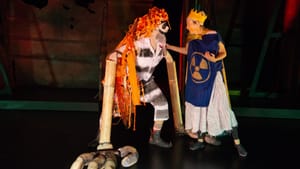Stay in the Loop
BSR publishes on a weekly schedule, with an email newsletter every Wednesday and Thursday morning. There’s no paywall, and subscribing is always free.
Cowabunga!
Wilma Theater presents Anne Washburn's 'Mr. Burns: A Post-Electric Play'

Mr. Burns, A Post-Electric Play, rides the new millennium’s wave of post-apocalyptic stories in novels, films, television shows, graphic novels, computer games, and plays. The Wilma Theater’s production of Anne Washburn’s acclaimed 2012 script provides no stock scenarios or straightforward themes, let alone familiar devices like zombies.
Mr. Burns’s three acts, playing at three hours with two intermissions under Russian director Yury Urnov, tell a thematic, rather than character-driven, story. In the first act’s near future, society has crumbled due to an unexplained power outage. People scavenge in packs, tote guns, and have already developed a ritual of sharing information about missing loved ones: each can only ask about 10 people.
Nostalgia for now
To amuse and distract each other, they reassemble the “Cape Feare” episode of The Simpsons from memory. Seven years later in Act II, the group is one of several traveling companies performing old television commercials and Simpsons episodes. People are adjusting to primitive life but yearn for the old days; the troupe’s commercial re-creations conjure longings for baths, refrigerators, and chocolate cake.
The first two acts chart a fascinating approach to survival: share memories of the good old days for people living bleak lives. Like any theater company, they wish for more resources, squabble often while working cooperatively, and fret about the competition.
Their creations, including a song and dance medley of half-remembered pop hits, are great fun. “Meaningless entertainment is actually really hard,” one complains; nostalgia can suddenly turn dark for people who have lost so much.
Act III jumps 75 years, imagining how the “Cape Feare” episode morphs over time as it’s passed between performers and generations. At this point, Mr. Burns no longer tells a story about characters but explores how stories evolve. The original is barely recognizable in this operatic morality play. The cast sings and plays Michael Kiley’s clever score composed for this production with many sly references to pre-apocalypse music.

Don’t have a cow
The actors, most members of the Wilma’s Hothouse Company, excel in this challenging work. Ross Beschler, Sarah Gliko, Jered McLenigan, Campbell O’Hare, Brett Ashley Robinson, and Lindsay Smiling are Act I’s fragile survivors, joined by Mary Tuomanen in Act II.
They develop rich, complex personas with little exposition in the first act, and show how people from various parts of society remake themselves as Act II’s close-knit company. Act III’s ritualistic performance requires constant movement and musicmaking, testing their stamina.
Set designer Misha Kachman places the first two acts in configurations of shipping containers (which are already being repurposed as homes today) and creates Act III’s abstract landscape. Costume designer Meghan E. Healey suggests how Act II’s performers contrive their outfits, and shapes religious-looking tunics and head covers for Act III. Thom Weaver’s lighting uses an array of flashlights and lanterns to show the ways the survivors keep darkness at bay in Act I, sneaking more bold illumination into the other acts.
The first two acts’ compelling characters could be a fine story on their own, and the lack of a satisfying narrative arc might frustrate audiences expecting a more traditional tale. The third act – when The Simpsons is interpreted by and performed for people who never saw the show – forces us to consider how stories evolve and what they provide for audiences.
What will a post-apocalyptic society salvage from today’s art and popular culture? What stories will unite and guide us? Which contemporary stories might thrive in a future society? How do stories change to fit their audiences?
Anne Washburn, Yury Urnov, and the Wilma Theater want Mr. Burns, A Post-Electric Play to consider these questions and more.
What, When, Where
Mr. Burns, A Post-Electric Play. By Anne Washburn, Yury Urnov directed. Through November 11, 2018, at the Wilma Theater, 265 S. Broad Street, Philadelphia. (215) 546-7824 or wilmatheater.org.
Sign up for our newsletter
All of the week's new articles, all in one place. Sign up for the free weekly BSR newsletters, and don't miss a conversation.

 Mark Cofta
Mark Cofta